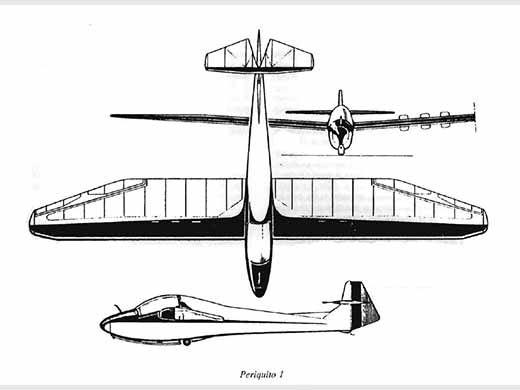
IPD Periquito I
Autre nom (ou nom en langue originelle) : PQ-1 Periquito I| DONNÉES GÉNÉRALES |
| Année du premier vol (ou de design, si seul projet) |
1957 |
| Pays | Brésil |
| Designer(s) | PESSOTTI, Guido & al. |
| Premier constructeur | IPD - Institute de Pesquisas e Desenvolvimento, São José dos Campos (São Paulo, BZ) |
| Type d'appareil | Planeur |
| Fonction | Entraînement |
| SPÉCIFICATIONS TECHNIQUES |
| Envergure | 9 m |
| Longueur | 5.45 m |
| Hauteur | 1.05 m |
| Allongement | 8.2 |
| Surface alaire | 9.8 m2 |
| Profil aile | -- |
| Masse à vide | 75 kg |
| Masse maxi | 155 kg |
| Charge alaire | 17 kg/m2 |
| Vitesse mini | -- |
| Vitesse maxi | -- |
| Finesse maxi | 19 |
| Taux de chute mini | 0.85 m/s |
| Nb sièges | 1 |
| Structure | Bois et toile |
AUTRES INFORMATIONS
| Constructeur(s) |
| ||||||
| Infos techniques | -- | ||||||
| Histoire résumée | The Periquito I developed at the Aeronautical Research and Development Institute, Sao Jose dos Campos, Sao Paulo, was designed to fulfill the following requirements as indicated in order of priority - 1- Low fabrication cost 1.1- Small size 1.2· Use of unskilled labour 1.3- Common and ,inexpensive construction materials 1.4- Design demanding a minimum number of parts and manufacturing operations 4- Practical operation 4.1- Easy and quick disassembling (for storage) 4.2- Easy launching aimed at the practice of 'individual flight' 4.3- Safety and resistance to handling over long periods of utilisation 4.4- Simplicity on retrieving and .easy transport.ation (on top of automobile or in trailer towed by motorcycle) The Periquito I incorporates a number of non-conventional solutions: The wings can be folded easily in a penknife fashion The balanced type elevator (in one single piece) disconnects itself, requiring only one bolt to be loosened by hand. All this enables a single person to de-rig the glider in less than one minute. The folded glider occupies an area of only 5.8m x 0.9 m (19' x 3'). The construction of the first prototype took a total of 1450 man hours, including the jigs. The performance data given here is calculated only, since we have yet not been able to make more precise flight tests. Comparative flights have been carried out with a Grunau Baby II, with closed cockpit, which served to check pproximately these calculated curves. In the low speed range, the two gliders are similar, but over 65 km/h, approximately 40 mph, the Periquito starts to push forward more markedly. The construction of the glider was completed shortly before the 4th Brazilian Soaring Championship in 1957, so that the pilot had the chance to perform only two short familiarisation flights, before the beginning of the championship, having been classified in the second place against Grunaus, flying in a restricted category. Using the first prototype as basis, we came to the conclusion that the weight is not as critical as first thought, and thus, the proposed modifications for the second prototype will mainly be aimed at greater simplicity and greater safety, at the expense of a small weight increase. It win be designed not only for spruce, hut also for the Brazilian wood 'Freijo', which is easier to procure in our Country. Apparently trifling, but numerous modifications, will cut construction work of the Periquito II to 1000/ 1100 man-hours. Our work schedule, which is being carried out by a very small group (three persons) calls fOF the preparation of the complete construction plans, construction of a flew prototype and detailed tests of the same, preparation of the construction manual and finally, the type certification according to local and USA Regulations. A local manufacturer has been awarded a contract for the manufacture of a few kits of this sailplane, that will be distributed among some clubs, as part of the evolution program. | ||||||
| Liens personnalités | Pas de personnalité associée. | ||||||
| Compléments docs |
SOURCES DOCUMENTAIRES
| Liens WEB | Pas de site référencé. |
| Livres | Pas de livre référencé. |
| Autres sources | The Popular Glider in Brazil, par Joseph Kovacs, VGC News n° 91, été 1997. Texte + plan 3 vues Periquito, par E. Ciani (de Volo a Vela), Aviasport. Texte + schéma + specs. [via François Deville, 22/10/2016] |

Team J2mcL © 2003 -
- Pages optimisées pour Mozilla Firefox

